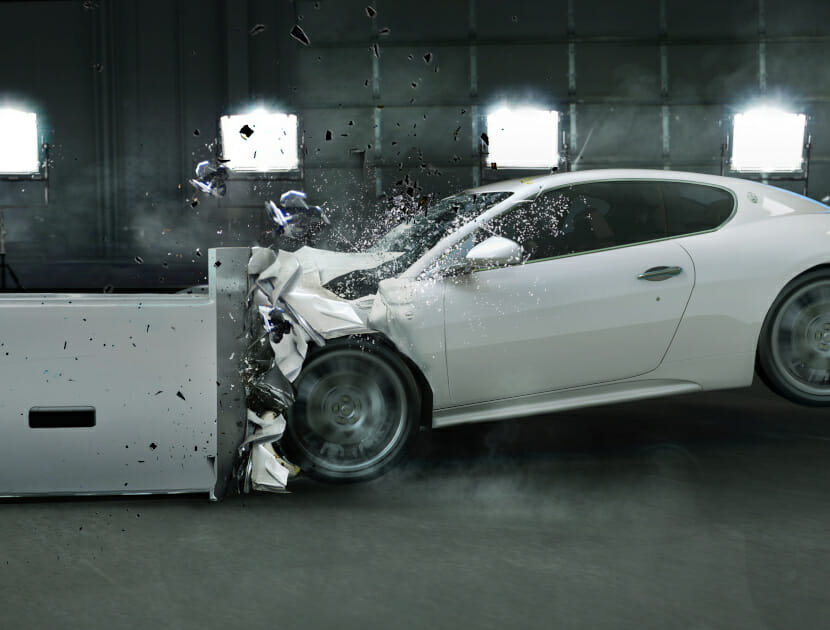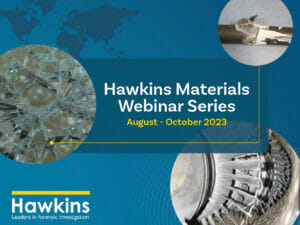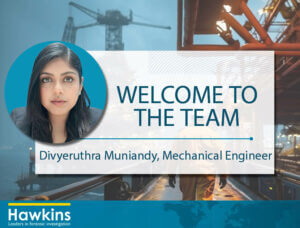Vehicle crashworthiness is the concept of protecting the occupants in the event of a collision. This covers all aspects of safety, from the vehicle’s ability to deform and absorb energy whilst maintaining the integrity of its occupant compartment, to the restraint systems used to help manage occupant movements.
CRASH STRUCTURES
Although each vehicle is unique, every car’s crash structure tends to follow a consistent pattern based on best practice for crashworthiness.
The structure of the occupant compartment is typically formed of very high-strength members, which are designed to direct impact forces around the occupants along dedicated load paths, in order to maintain the survival space. Outside of the occupant compartment, the vehicle has softer structures that are designed to absorb some of the energy of the impact, in order to reduce the accelerations experienced by those within the vehicle, as well as potentially lessening the levels of acceleration experienced by the striking vehicle/pedestrian.
Frontal structures are good examples of how this concept is applied. There is typically a relatively large distance between the occupant compartment and the point of impact in a frontal collision, and this distance allows for significant potential energy absorption. The foremost part of the vehicle’s crash structure has one or more lateral “bumper beams”, which are designed to compensate for any off-set or concentrated collisions by dispersing and directing the loads to the vehicle’s crash structure. The bumper beams are usually mounted to “crush cans”, which are designed to collapse longitudinally and absorb some of the impact energy. The remaining energy is then directed along specific load paths and around the occupant compartment. There are however, limitations to the amount of energy that can be redirected without the high-strength structures undergoing some level of deformation.
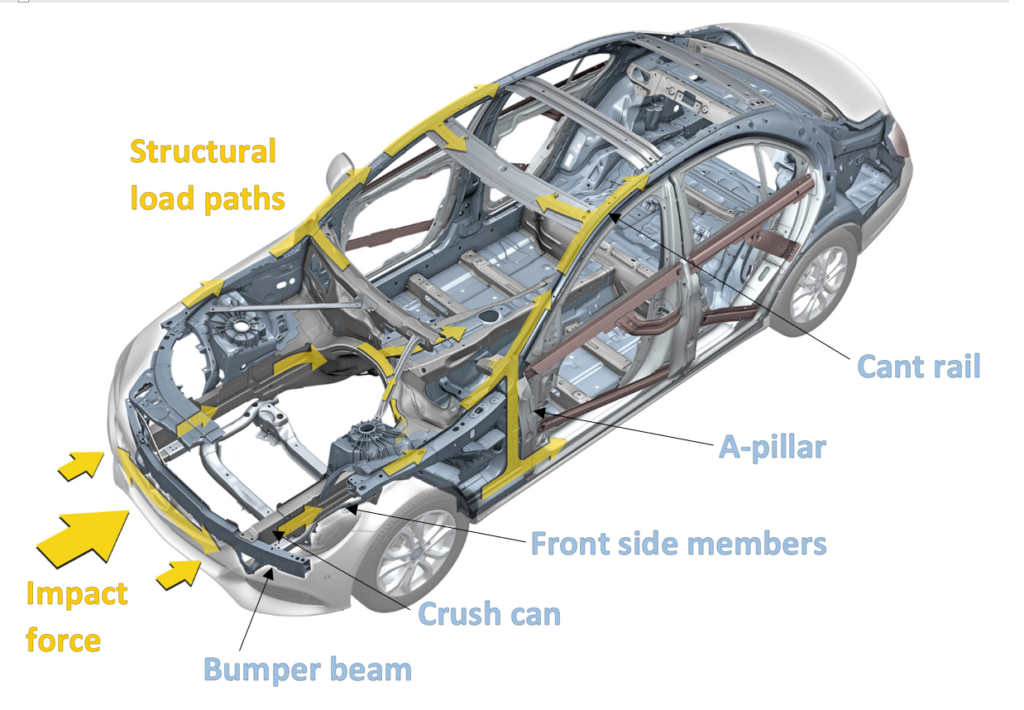
In a side impact there is very little of the vehicle’s structure that can deform before intruding into the occupant compartment. There are structural load paths designed to disperse what forces they can and maintain the occupant survival space. However, because of the limited space, early deployment of the side restraints is imperative.
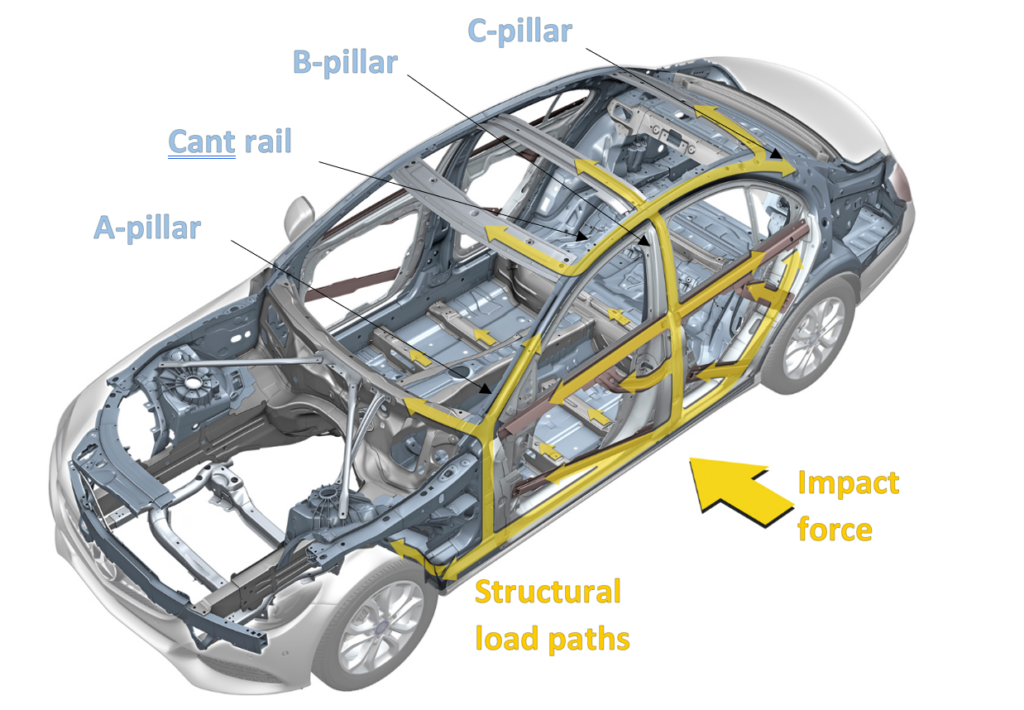
Crash tests have been developed to consider impacts with a variety of different structures. Objects with higher rigidity, and/or a smaller surface area, will lead to greater intrusion due to more concentrated loading on the vehicle. A good example of this concept is the difference between the Euro NCAP (New Car Assessment Programme) side impact tests using a rigid metal pole, intended to mimic objects such as lampposts and trees, in comparison with a deformable barrier, intended to mimic the front end of another vehicle. The metal pole is undeformed by the collision, meaning that nearly all of the kinetic energy is acting to deform the test vehicle, whereas the deformation of the barrier absorbs some of the kinetic energy from the impact itself.
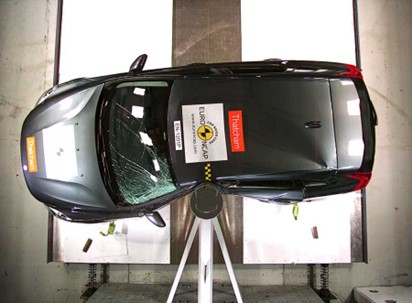
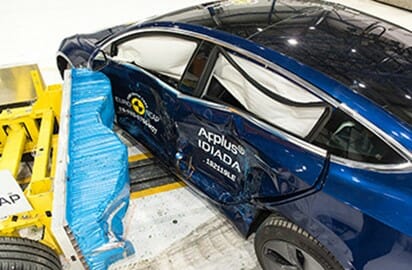
Different areas of a vehicle have different levels of stiffness that effect their resistance to deformation. An example is the relatively rigid structure of a vehicle’s A‑pillar in comparison to the soft structure towards the centre of a door. The centre of a door is typically a hollow section sandwiched by an inner and outer skin, made from either plastic or thin metal. This offers little resistance to intrusion and is one of the reasons that concentrated side impacts can be so dangerous for occupants. In contrast, the A-pillar and cant rail are designed to maintain their shape and act as structural load paths. However, their high rigidity can lead to severe injuries in collisions, often by vulnerable road users, such as pedestrians and motorcyclists, but even frontal occupants within the car can be impacted directly by contact of these areas in certain collision circumstances.
To help improve the all-round crashworthiness in situations like these, technologies have been developed and optimised to better protect those involved in a collision, both inside and outside the vehicle. For example, in side impacts, there is relatively little distance between the colliding object and the occupants within the struck vehicle, therefore pressure sensors have been added to the door cavities. This allows the supplementary restraints system (i.e., those components activated during a collision, such as airbags and seatbelt pretensioners) to recognise an impact before other sensors, and deploy quickly to help protect occupants. As for those outside of the vehicle, some manufacturers have begun fitting external vehicle airbags which deploy upon detecting a pedestrian impact and raise the height of the bonnet, creating more space between its upper surface and the hard components beneath it, as well as aiming to cover high stiffness areas such as the A-pillar.

FORENSIC RECONSTRUCTION
In collision reconstruction, investigators are often required to estimate the pre-impact speed of vehicles, with limited information to complete an accurate calculation. In some cases, the only physical evidence that investigators are presented with are photographs of the damage to the vehicle. Such estimations are based upon the experience of the investigator and are typically referenced to empirical data, predominantly crash tests. In this instance my familiarity with a vast number of different crash scenarios on different vehicle types allows me to draw on a deep understanding of impact speed and vehicle deformation patterns.
Consideration of occupant kinematics and their interaction with the vehicle’s restraints is a vital part of collision reconstruction. Understanding the restraints within the vehicle, their design intent and their deployment conditions is key to this aspect. Often the question of whether those restraints were in-use or operated correctly is critical to understanding the injuries sustained by occupants. In addition, if it is found that restraints were not in-use, then consideration of how the use of restraints in specific collision circumstances would have affected the occupant’s kinematics is important, as it can inform medical experts and allow them to draw conclusions regarding potential injury mitigation or prevention.
ABOUT THE AUTHOR
Ross Clarke graduated from Loughborough University in 2013 with a master’s degree in Automotive Engineering. Ross previously worked at Millbrook Proving Ground where he worked closely with manufacturers to conduct hundreds of tests designed to evaluate the crashworthiness of many different aspects of a vehicle. From 2016 he then set up his own company to provide crash safety consultancy services to OEM’s. He won multiple contracts with Nissan over 3 years, where he developed their new and existing vehicles’ crash safety performance for their global markets. This involved working on projects from initial concept to lifecycle updates, in order to ensure that the vehicles exceeded all of the stringent safety objectives set by the client, the manufacturer, regulators and to meet the different market requirements. He is based in London but has worked throughout the world. For three years prior to joining Hawkins, Ross provided a consultancy service to Nissan to develop the crashworthiness of their vehicles, including their flagship crossover and electric vehicles. This unique experience has proven an invaluable asset for conducting forensic investigations of road traffic collisions.
